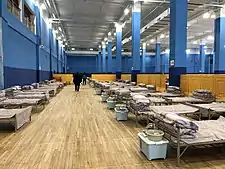Fangcang Hospital
Fangcang Hospital (Chinese: 方舱医院; pinyin: fāngcāng yīyuàn; lit. 'square-cabin hospital')[1] refers to a kind of makeshift/mobile field hospitals notably used during the COVID-19 pandemic in Wuhan, Hubei, China.
| Fangcang Hospital | |
|---|---|
 A Fangcang hospital in Wuhan in February 2020 | |
| Geography | |
| Location | China |
| Organisation | |
| Type | Makeshift hospital |
| Links | |
| Lists | Hospitals in China |
History and usage
Such hospitals were intended for large-scale medical isolation and instituted either by establishing rapidly constructed modular/portable buildings, or through the acquisition of indoor space within existing venues and even temporarily renovated gyms and dorms in colleges and universities with enclosed cubicles to assist social distancing.
In Wuhan, since the outbreak of the coronavirus disease 2019, the general medical institutions and the newly expanded pneumonia specialist hospital became overcrowded due to the sudden surge in hospital bed demands, and high-level care must to be prioritized to severely ill patients. Meanwhile, the large number of low-severity cases — almost all are individuals with suspected or mild symptoms — still needed at least a fortnight of isolation (due to the incubation period of SARS-CoV-2), but voluntary home isolation is not always properly complied and could also risk infecting family members and neighbors, and in-hospital isolation will hold up medical resources and increase the risk of nosocomial exposure. Under such circumstances, the principle of centralized low-level care management of non-critical patients was adopted. The Government of the People's Republic of China established 16 square-cabin hospitals in Wuhan, providing a total of more than 20,000 beds.[2][3][4] As of March 10, 2020, all patients admitted to the square cabin hospital of Wuhan Wushan Hongshan Stadium were discharged. Thus, all 16 square cabin hospitals in Wuhan completed their missions and their cabins were shut down.[5]
China has constructed Fangcang hospitals during the 2008 Sichuan earthquake and 2010 Yushu earthquake.[6][7] Chinese literature has mentioned the concept of "medical Fangcang" as early as 1989.[8]
Etymology
Fangcang (simplified Chinese: 方舱; traditional Chinese: 方艙; pinyin: fāngcāng), lit. "square cabin", is a Chinese term refer to a portable modular building structure formed using a combination of various solid materials, most notably cargotectures. The concept "Fangcang" was introduced from the United States military, who has been making makeshift structures since the 1950s.[9]
Outside of the context of the outbreak, makeshift or Fangcang structures can be referred to many kinds of modular structures.[9]
Locations in Wuhan

The following Fangcang hospitals were in use in Wuhan during the COVID-19 pandemic:[10]
- Wuhan International Conference & Exhibition Center, Jianghan District
- Hongshan Stadium, Wuchang District
- Wuhan Living Room, Dongxihu District
- Wuhan National Fitness Center, Jiang'an District
- Hongqiao Industrial Park, Jing'an District[11]
- Wuhan Stadium, Qiaokou District[12]
- Wuhan International Expo Center, Hanyang District
- Wuhan Sports Center Stadium, Wuhan Development Zone
- Shipailing Senior Vocational High School, Hongshan District
- Optics Valley Convention & Exhibition Center, Donghu Development Zone
- Wuhan Meilian Group’s former Rihai Industrial Park plant, Hongshan District
- Dahua Mountain Outdoor Sports Center, Jiangxia District
- Huangpi Stadium, Huangpi District
- WISCO Sports Center, Qingshan District
- Yangtze River Media Zhiyin Practice Training Base, Caidian District
Outside Mainland China
The first comparable makeshift hospital built during Russia's outbreak was built in the suburban of Moscow in March 2020.[13] Similar makeshift hospitals were successively built in countries including Iran, Spain, United Kingdom and the United States.[14][15][16][17]
References
- Vlog: A look into a mobile cabin hospital Video on YouTube
- 武汉方舱医院增至12家 计划启用床位超两万张-新华网. www.xinhuanet.com. Archived from the original on 2020-04-11. Retrieved 2020-02-20.
- Yu, Verna (2020-02-18). "Senior Wuhan doctor dies from coronavirus as authorities start to 'round up' patients". The Guardian. ISSN 0261-3077. Archived from the original on 2020-04-23. Retrieved 2020-03-30.
- hermesauto (2020-02-21). "Coronavirus: Wuhan to build 19 more makeshift hospitals as China struggles to contain epidemic". The Straits Times. Archived from the original on 2020-04-11. Retrieved 2020-03-30.
- "Wuhan to ease lockdown as world battles virus". BBC News. 2020-03-24. Archived from the original on 2020-04-11. Retrieved 2020-03-30.
- 新华社. "解放军第一所野战方舱医院18日在绵阳南郊展开". 中国政府网. Archived from the original on 2021-01-26. Retrieved 2020-08-03.
- 新华网. "回良玉到玉树地震灾区考察 强调抗震救灾进入新阶段". 中华人民共和国外交部驻香港特别行政区特派员公署. Archived from the original on 2021-01-26. Retrieved 2020-08-03.
- 王益群,顾正明.军用方舱简介[J].系统工程与电子技术,1989(01):66-68.
- 冀中仁.追根溯源话方舱[J].中国军转民,2012(09):43-47.
- Fang, Dongping; Pan, Shengjie; Li, Zaishang; Yuan, Ting; Jiang, Benran; Gan, Di; Sheng, Bai; Han, Jing; Wang, Tao; Liu, Zhongmin (June 2020). "Large-scale public venues as medical emergency sites in disasters: lessons from COVID-19 and the use of Fangcang shelter hospitals in Wuhan, China". BMJ Global Health. 5 (6): e002815. doi:10.1136/bmjgh-2020-002815. Archived from the original on 2020-11-24. Retrieved 2021-01-18.
- 武汉谌家矶"方舱医院"即将完工 新添3840张床位_腾讯新闻. new.qq.com. Archived from the original on 2020-04-11. Retrieved 2020-02-20.
- 武汉首家方舱医院"休舱" 康复者均已出院. news.ifeng.com. Archived from the original on 2020-04-11. Retrieved 2020-03-30.
- 俄罗斯也开始在莫斯科建方舱医院了. m.yicai.com. Archived from the original on 2020-04-11. Retrieved 2020-03-30.
- 学习中国经验!总台记者独家探访伊朗版"方舱医院". app.cctv.com. Archived from the original on 2020-04-11. Retrieved 2020-03-30.
- 肺炎疫情全球确诊30万 西班牙开设方舱医院. BBC News 中文 (in Chinese). 2020-03-22. Archived from the original on 2020-04-11. Retrieved 2020-03-30.
- 英国版方舱医院准备建设. www.yicai.com. Archived from the original on 2020-04-11. Retrieved 2020-03-30.
- 从纽约到德黑兰,全球多地建起"方舱医院". www.bjd.com.cn. Archived from the original on 2020-04-11. Retrieved 2020-03-30.